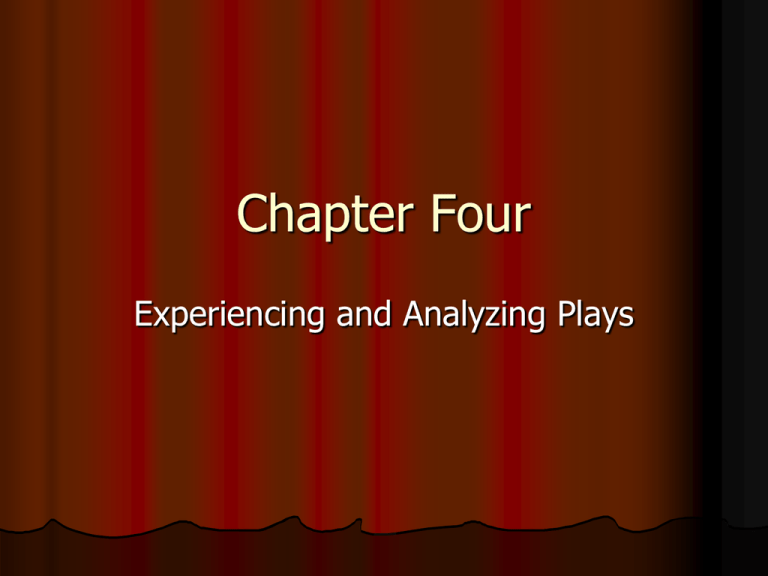Chapter Four
advertisement

Chapter Four Experiencing and Analyzing Plays James Estrin/The New York Times/Redux Pictures Tools for Analysis Three Unities Unity of Time Unity of Place Unity of Action Plays can follow all of the unities, some or none Useful as a starting point for analysing the play’s structure, use of time and place and any subplots. Aristotle’s Poetics The Six Elements of Drama 1. Plot – what is the story about? 2. Character – Who is doing the action? 3. Thought – What do the actions in the play mean? 4. Diction – How is the dialogue used to reveal character and set the environment? 5. Song – How do the musical elements of the play move the plot to its conclusion? 6. Spectacle – How do each of the visual and auditory elements of the play contribute to the performance? Protagonist and Antagonist A protagonist is the central character in a literary work. An antagonist is a character (or element) who is opposite to or challenges the protagonist." (http://rwc.hunter.cuny.edu/reading-writing/on-line/lit-terms.html) The protagonist doesn’t need to be “good” Macbeth does many evil deeds but he is the protagonist of the play, Macbeth. Goethe Three Essential Questions Dramatic Criticism Should Address 1. What is the artist trying to do? 2. How well has the artist done it? 3. Is it worth doing? http://www.sfmoma.org/explore/multimed ia/videos/111 Levels of Participation Presentational Theatre Representational Theatre is self-consciously theatrical and will often acknowledge the audience and may even invite them to participate is based on the idea of the “fourth wall,” in which the actors never acknowledge the presence of the audience Example – Example – The Rocky Horror Picture Show A Doll’s House Three Factors by which Theatre Artists Manipulate their Audiences 1. Group Dynamics – how people function when members of a group Emotion overcomes the intellect Laughter becomes infectious 2. Willing Suspension of Disbelief – we accept the world of the play over that of our everyday reality Kevin Berne/Courtesy American Conservatory Theater Three Factors by which Theatre Artists Manipulate their Audiences Sygma/Corbis 3. Aesthetic Distance – the audience’s ability to remove themselves so that they can contemplate and evaluate the performance and the play Do not come late and don’t leave until intermission or the end. Do not talk. Turn off cell phones and don’t text or tweet. Do not take photos or use recording devices. Richard Feldman Etiquette in the Theatre Going to the Theatre Check your local paper, TV, or websites for play listings. Reserve your nonrefundable tickets. To save money, attend preview performances or check for student rates. Observe the dress code for that theatre. Read the program to be better informed. Analyze and discuss the performance after the show. Everyone is a Critic RICHARD PERRY/The New York Times/Redux Pictures Reviews are often short evaluations of a production presented in the print or electronic media that offer the opinion of whether the play’s worth attending. Everyone is a Critic AP Photo/Mary Altaffer Dramatic Criticism offers the reader a discriminating, often scholarly interpretation and analysis of a play, an artist’s body of work, or a period of theatre history.




